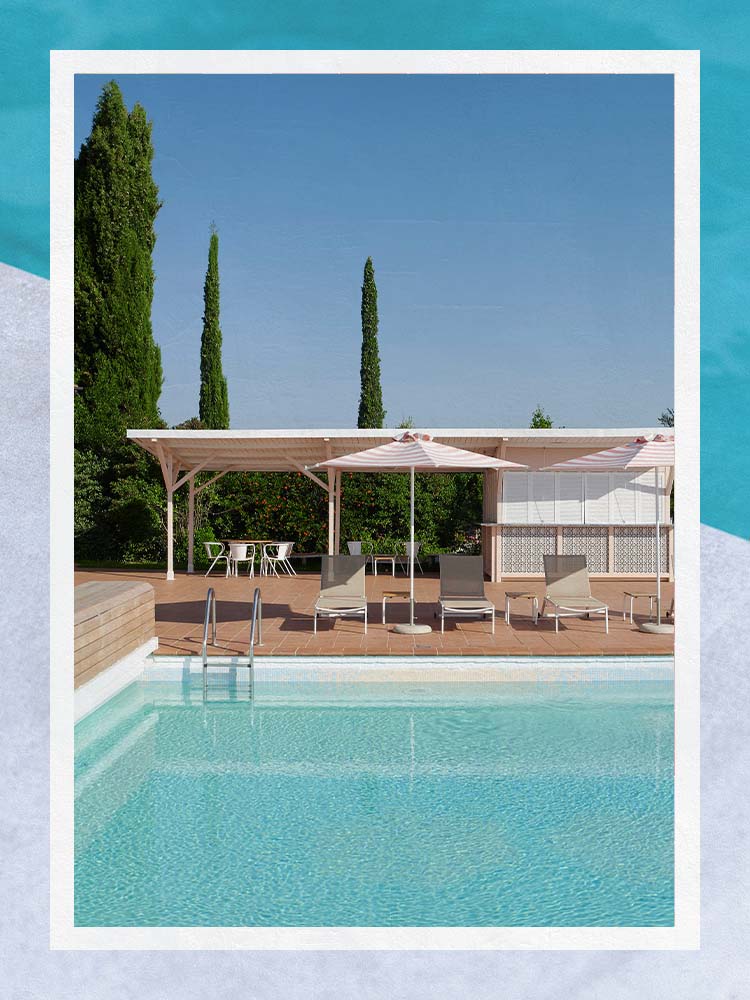The Best Pool Algicides Keep Your Water Sparkling, Without Harsh Chemicals
You can even use UV light to prevent the green stuff.
Published Apr 21, 2022 4:00 PM
We may earn revenue from the products available on this page and participate in affiliate programs.
Reading up on Domino’s shopping guides is like having your own personal product concierge. We do the tedious part—deep-dive research, hands-on testing, and tapping experts for advice—so all you have to do is hit “add to cart.” That’s why we call them Simply the Best.
Swimming pools are notoriously finicky when it comes to maintenance. That pristine blue water doesn’t come without some planning: Neglect to monitor the chlorine levels or skip a vacuum treatment, and the next thing you know, those crystal-clear waters have become cloudy pea soup. Say goodbye to the pool party.
That’s where algicides come in. “Quats” and polymer algicides use detergents and chemicals to kill algae, and some treatments involve “shocking” your pool with a high-chlorine concentration, which can come with its share of red eyes and irritated skin. Plus it’s off-limits to swimmers for 24 hours until the chlorine returns to safe levels.
The best pool algicides, in our book, rely on naturally occurring minerals or ultraviolet light to sanitize your pool, forgoing the need for harsh chemicals and reducing your pool’s dependency on chlorine. “Some people are sensitive to the chlorine,” says Mara McCartney, senior product manager at Fluidra, a company that makes products designed to help homeowners manage their pools. “Using less chlorine feels better on your hair and your swimsuit, and some people just don’t like using a lot of chemicals in their pool.”
Your pool is the sparkling centerpiece of summer entertaining, so read on for how to keep it clean all season long.
Our Favorites
- Best overall: Nature2 Express Mineral Pool Sanitizer
- Best value: Eclipse3 Algae Control System
- Best long-lasting: Pool RX 6 Month Algaecide
- Best low-maintenance: Frog Bam!
- Best alternative: Solaxx Precision UV Ultraviolet System
Best Overall: Nature2 Express Mineral Pool Sanitizer
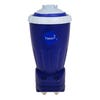
Type: Cartridge | Application: Place the disposable cartridge in the sanitizer | Longevity: 6 months
What we like:
- Cartridges last 6 months
- No mixing or diluting required
- Comes with a no-staining guarantee
Worth noting:
- Must purchase and install sanitizer
Why we chose it: Nature2’s sanitizer integrates with your pool’s plumbing for a safe, low-maintenance, and effective algicide.
The Nature2 system may be pricier than other algicides on the market, but it earns our best overall spot with an integrated setup that will help spare you the headache of weekly applications. Once you install the DIY-friendly system, the Nature2 uses disposable cartridges to deliver a steady flow of minerals for a full six months. “It releases the minerals slowly over time, and it releases only what the pool needs,” says McCartney. Unlike other algicides that require meticulous measuring and mixing, the cartridge system maintains the correct distribution for you, so you don’t have to worry about staining your pool’s walls—especially if you’ve put the time and energy into painting them—by accidentally overdoing it.
Best Value: Eclipse3 Algae Control System
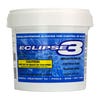
Type: Granules | Application: Dissolve granules in a bucket and apply to pool water weekly | Longevity: 1 week
What we like:
- Herbicide-free
- Affordable solution
- Uses natural minerals
Worth noting:
- Can stain pool if too much is applied
- Weekly applications required
Why we chose it: An affordable way to eliminate and prevent algae growth without using herbicides.
You don’t need to dump herbicides into your pool to get rid of the emerald haze creeping across the walls. Eclipse3 uses mineral granules and is our most affordable pick—no other hardware or materials required. After a large initial dosage to kill off any existing algae, you’ll use much smaller weekly doses to keep it at bay, so you’ll really get your money’s worth out of this 8.8-pound tub. For the greatest efficacy, apply Eclipse3 when the pool’s pH is in the ideal range of 7.2 to 7.6, and the alkalinity is between 50 and 200 parts per million. Be mindful, though: With granules like these, it’s crucial that you calculate the proper amount for your pool’s size and dilute them in water first, or else you could end up replacing your algae with an equally unappealing copper stain.
Best Long-Lasting: PoolRX Six Month Herbicide
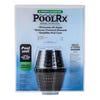
Type: Cartridge | Application: Place in the pool skimmer basket or pump basket | Longevity: 6 months
What we like:
- Works for 4 to 6 months
- Sits out of sight in the pump basket or pool skimmer
- Mineral-based
Worth noting:
- High price tag
Why we chose it: RXPro works for up to six months while discreetly tucked away in your pool’s pump basket.
Let’s face it: A swimming pool is a lot of work. It’s no wonder some people opt for a chic inflatable model instead. So anything that can help cut down on maintenance demands is a good thing. Unlike most other algicide products, RXPro doesn’t need to be added to the water weekly or even monthly. It sits out of sight and out of mind in your pump basket or pool skimmer, quietly killing off algae and warding off future growth for up to six months. That alone makes it worth its higher price tag. Since it’s mineral based, it is not releasing chemicals into the pool water either, so you can swim freely with no threat of red eyes or itchy skin. For best results, make sure you purchase the right size model for your pool.
Best Low-Maintenance: Frog Bam!
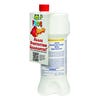
Type: Cartridge | Application: Place the disposable cartridge in the cycler | Longevity: 3 months
What we like:
- Works for 90 days
- The cartridge system is user-friendly
- No need to come into contact with minerals
Worth noting:
- Requires the up-front cost of a Frog cycler
Why we chose it: Once installed, this system offers one of the simplest, most user-friendly ways of managing algae.
While the Frog algae treatment does require an installation of its full cycler system (bonus points if you already have one!), the maintenance time you’ll avoid makes it a worthy investment. The Frog cycler ties directly into the line leading from your pool to the pool filter: As water passes through it, the cartridge inside the cycler adds small amounts of minerals that keep algae in check. There’s no need to manually add algae treatment to the water, and thus no risk of oversaturating the pool and staining the walls. And since each cartridge lasts a full 90 days, you can say farewell to weekly treatments and focus on enjoying daily dips.
Best Zero Chemical: Solaxx Nuvo Ultraviolet Water Sterilizer
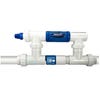
Type: Ultraviolet light | Application: Onetime sterilizer installation | Longevity: N/A
What we like:
- Adds no substances to the water
- Maintenance-free design
- Also kills bacteria and viruses immune to chlorine
Worth noting:
- Expensive up-front cost
- Won’t kill algae clinging to surfaces
Why we chose it: Solaxx prevents algae growth without chemical or mineral additives.
If your goal is to avoid chemical or mineral additives entirely, then an ultraviolet light sterilizer is the way to go. Rather than dissolving algae-killing solids into the water, Solaxx’s Nuvo system uses ultraviolet light to eliminate all algae spores that pass through it, as well as kills any chlorine-resistant bacteria and viruses. This high-tech approach comes with a high cost, though—it is the most expensive algicide on our list and does have limitations. Because the system kills algae spores as it filters water, it can’t actually eradicate algae clinging to the side or bottom of your pool. So if you currently have an algae problem, you’ll need to start with another algicide solution as well. But with a little careful planning, the Solaxx Nuvo system could keep your pool sparkling and algae-free for years to come, with little to no work on your part. This particular model is for in-ground pools, but Solaxx also makes one for aboveground pools.
How We Chose These Products
First, we narrowed down our list to algicides that were safest for swimmers and the environment: We opted for mineral-based products and ultraviolet light sanitizers. Of those, we selected algicides that are the most effective at eliminating algae and controlling new growth. With the exception of our value choice, we chose algicides for pools that extend the time between applications and require no weekly maintenance. While mineral treatments use only natural ingredients, if they’re not applied properly, the copper in them can potentially cause staining to your pool. This is why most of the algicides on our list use disposable cartridges to disperse the minerals evenly without any measuring and mixing.
Our Shopping Checklist
Ingredients and Formula
We think the best pool algicides use minerals or ultraviolet light, rather than harsh chemicals, to control algae. Copper sulfate, which kills algae by attaching itself to algae cells and breaking them apart, is the active ingredient in most mineral-based algicides. The most affordable mineral algicides come in granule form, which must be measured and mixed with water before adding to your pool. If you don’t mind the additional up-front expense, cartridge algicides utilize a sanitizer unit that is integrated into your pool’s pump and filtration system. The sanitizer uses a refillable cartridge that treats the pool water for up to six months. Pool algicides that use ultraviolet light can kill algae spores without adding any substances to the water at all.
Safety and Efficacy
Though we’ve limited our search to algicides that use natural minerals, there are still safety considerations you’ll want to keep in mind. The copper sulfate found in mineral pool treatments is not as harsh or toxic as the algicides that rely on herbicides, but you need to be careful with how much you add and how you add it. In high concentrations, copper sulfate will stain the walls of a pool or even the hair of blonde swimmers. “If you’re going to use types of algicides with metals in them, I would strongly suggest a good sequestering agent,” says Jon Temple, founder of Jacksonville, Florida–based Tempool. Sequestering agents are additives that prevent the algicide from staining. Another option is to use cartridges that distribute an even amount of minerals into the water.
Since small amounts of copper sulfate are distributed throughout the water, it kills existing algae while also serving as a preventative against any new growth. Ultraviolet pool sanitizers don’t add any substances to the water, so they are the safest of all algicides. However, their efficacy is limited—they can only treat water that flows through them. They won’t take out any algae sticking to the floor and walls of your pool.
Pool Care and Maintenance
Although they are pricier, cartridge systems will eliminate the human error that can lead to high concentrations and staining. They also last for months, so there’s no need for weekly pool treatments. If you opt for the more affordable granules, be sure to use the correct measurement for the volume of your pool to avoid staining.
Ask Domino
Q: Beyond products, what’s the best way to remove algae from a pool?
The best way to keep your pool sparkling is by avoiding algae in the first place. Keeping the proper pH balance and promptly removing organic material with a pool skimmer will prevent it from taking hold. “l’d spend more time brushing and vacuuming and cleaning my filter than swimming in a pool with a lot of chemistry in it,” says Temple. “A little more maintenance and a bit more physical work are better than just throwing a lot of chemicals in your pool.”
Q: So how often do I need to use an algicide?
How often you should use an algicide depends on the type. Most granule-based products are added on a weekly basis, while cartridge-style algicides will last for months before needing to be replaced.
Q: I don’t have a vacuum. How do I get algae off the bottom of my pool?
The best way to get algae off the bottom and sides of a pool is by using a stiff nylon brush. Scrubbing the bottom will release the algae into the water, where it can be pumped into the pool’s filtration system.
Q: Why does my clear pool water look green?
Pool water looks green when there is a chemical imbalance that has allowed algae to bloom. Use an algicide or shock the pool to kill off the algae, then use a pool test kit to get the pH level back to a range between 7 and 7.6.
The Last Word
Whether you have a small aboveground pool or a large, in-ground oasis, there’s a good chance algae will, at some point, cloud its blue waters. Unless you don’t mind the side effects that come with using high levels of chlorine to kill the algae in your pool, we recommend using a mineral-based algicide or ultraviolet sanitizer that can return your pool to its pristine condition without the need for harsh chemicals.
